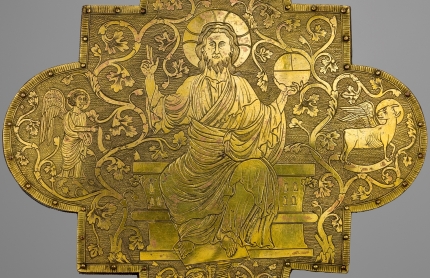Virtuoso techniques
Throughout his work, Hugo d’Oignies highlighted the various artistic methods. Unlike his contemporaries, however, who often used colour through numerous incrustations of precious stones and enamel, Hugo’s work is more sober, less coloured, with the accent placed more on the technical virtuosity of working the metal itself. He paid great attention to the quality of his drawings and their interpretation; he did not hesitate to juxtapose or combine different styles and technique. Whilst the subjects chosen by Hugo are of the very purest Christian tradition, we nevertheless discover in the “margins” of his work, rather like certain manuscript illuminators, a wealth of motifs and great imagination in his choice of iconography.
Among the techniques in which Hugo excelled, we can mention in particular niello, filigree, chasing and stamping. Niello involves making an incision in a sheet of precious metal and filling in the spaces left with an alloy of copper, lead and sulphur. Once fired, the mixture becomes black and contrasts with the polished surface of the metal. Filigree requires great manual dexterity because it requires working with very fine silver and gold wire to make superimposed curves and interlacing in relief on the metal surface. Whilst Hugo’s chasing demonstrates his indisputable drawing talents, it was the technique of stamping – which enables motifs to be repeated thanks to the use of a hollowed-out die – that provided him with new possibilities of composition, which were lighter and fresher, that built his fame.
Hugo d'Oignies, Evangeliary bookbinding plates, post 1228 - c. 1230.
Hugo d’Oignies at prayer, represented in the lower left of the reliquary plate Christ in Majesty. In this work by Brother Hugo, we can admire the range of his artistic talents through the various techniques he employed: nielloed plates, stamped with foliage and figurative décor in filigree.
Hugo d'Oignies, Chalice, said to belonged to Gilles de Walcourt, 1228.
Of great beauty, the foot of this chalice, said to have belonged to Gilles de Walcourt, shows the incomparable know-how of Brother Hugo. It is decorated with ten nielloed lobes, representing biblical characters and is set with large pearls.
Hugo d'Oignies, Reliquary of the rib of saint Peter, 1238.
A work of Brother Hugo, this reliquary containing a rib of Saint Peter represents on the front of the crescent a filigree décor of spirals with vine leaves and bunches of grapes. Figures of armed hunters and their dogs chasing deer can also be seen.
Hugo d'Oignies' workshop, Second phylactery of Saint André, c.1230-1235.
The reverse side of the second phylactery of Saint Andrew represents Christ seated on a large bench, holding a globe of the earth in his hand and surrounded by haloed symbols of the evangelists. The iconographic vocabulary employed by Brother Hugo sometimes provides infinite nuances between his works. It is also worth noting the extraordinary technical quality of execution of the relief, engraving and chasing of the foliage.
Hugo d'Oignies' workshop, Phylactery of Saint Martin, c. 1230.
If only by its dimensions and sumptuous appearance, the phylactery of Saint Martin is one of the most important works in the treasure. On the front, edged with a pearl cord, are large rock crystal cabochons. Silver palmed plaques, pointed and stamped, have been added between each of the lobes in which a cabochon is set.










